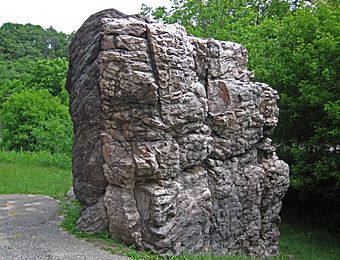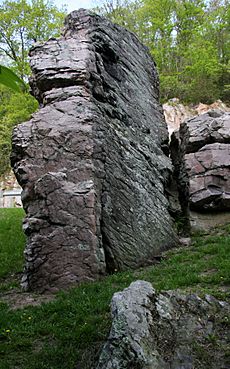Van Hise Rock facts for kids
|
Van Hise Rock
|
|

Van Hise Rock in 2015
|
|
| Location | Sauk County, Wisconsin, USA |
|---|---|
| Nearest city | Rock Springs, Wisconsin |
| NRHP reference No. | 97001267 |
Quick facts for kids Significant dates |
|
| Added to NRHP | September 25, 1997 |
| Designated NHL | September 25, 1997 |
Van Hise Rock is a very large, single rock formation in Wisconsin. You can find it along Wisconsin Highway 136 near Rock Springs. This rock is super important to geologists because it's a great example of a type of rock called Baraboo Quartzite.
The rock is named after Charles Van Hise. He was a famous geologist from Wisconsin who studied this area a lot. In 1997, Van Hise Rock was named a National Historic Landmark. This means it's a special place recognized for its history or natural importance.
Contents
What is Van Hise Rock?
Van Hise Rock is made of a rock called quartzite. This particular type is known as Baraboo quartzite. It has a cool pink-purple color and is found in central Wisconsin.
This rock is one of the best places to see the Baraboo Range. The Baraboo Range is a big ring of quartzite hills. It stretches across Columbia and Sauk Counties.
How the Rock Formed
The quartzite in these hills started as sandstone. This happened a very, very long time ago, during the Precambrian time. That's billions of years ago!
Over time, the sandstone changed into quartzite. This change happened because of intense heat and pressure deep underground. It's like baking a cake, but with rocks!
Where to Find It
You can visit Van Hise Rock easily. It's located in a special pull-off area next to Wisconsin Highway 136. This spot is about three-quarters of a mile north of where Highway 136 meets Wisconsin Highway 154. It's close to the village of Rock Springs.
The Story of Charles Van Hise
The rock is named to honor Charles Van Hise. He was a very important geologist. He even led the geology department at the University of Wisconsin–Madison.
Van Hise's Discoveries
Charles Van Hise made many big discoveries in geology. He figured out how the quartzite in the Baraboo Range was formed. Other scientists had already found out that the quartzite formed in the Precambrian Era. They also knew it had changed from sandstone.
Van Hise then discovered the powerful forces that shaped the rock. His work helped create the main ideas of structural geology. This is the study of how rocks are bent and broken.
Writing About Rocks
In 1904, Van Hise wrote a book called Treatise on Metamorphism. This book was the first to explain in detail how rocks change. This process is called metamorphism.
Even today, geologists from the University of Wisconsin use Van Hise Rock. They use it to show students the rock properties and ideas Van Hise discovered. The rock is still used for learning and research about geology.




